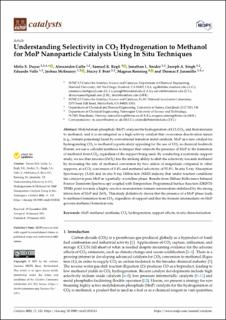| dc.contributor.author | Duyar, Melis S. | |
| dc.contributor.author | Gallo, Alessandro | |
| dc.contributor.author | Regli, Samuel K. | |
| dc.contributor.author | Snider, Jonathan L. | |
| dc.contributor.author | Singh, Joseph A. | |
| dc.contributor.author | Valle, Eduardo | |
| dc.contributor.author | McEnaney, Joshua | |
| dc.contributor.author | Bent, Stacey F. | |
| dc.contributor.author | Rønning, Magnus | |
| dc.contributor.author | Jaramillo, Thomas F | |
| dc.date.accessioned | 2021-03-01T12:11:00Z | |
| dc.date.available | 2021-03-01T12:11:00Z | |
| dc.date.created | 2021-02-26T15:37:00Z | |
| dc.date.issued | 2021 | |
| dc.identifier.citation | Catalysts. 2021, 11 143-?. | en_US |
| dc.identifier.issn | 2073-4344 | |
| dc.identifier.uri | https://hdl.handle.net/11250/2730918 | |
| dc.description.abstract | Molybdenum phosphide (MoP) catalyzes the hydrogenation of CO, CO2 , and their mixtures to methanol, and it is investigated as a high-activity catalyst that overcomes deactivation issues (e.g., formate poisoning) faced by conventional transition metal catalysts. MoP as a new catalyst for hydrogenating CO2 to methanol is particularly appealing for the use of CO2 as chemical feedstock. Herein, we use a colloidal synthesis technique that connects the presence of MoP to the formation of methanol from CO2 , regardless of the support being used. By conducting a systematic support study, we see that zirconia (ZrO2 ) has the striking ability to shift the selectivity towards methanol by increasing the rate of methanol conversion by two orders of magnitude compared to other supports, at a CO2 conversion of 1.4% and methanol selectivity of 55.4%. In situ X-ray Absorption Spectroscopy (XAS) and in situ X-ray Diffraction (XRD) indicate that under reaction conditions the catalyst is pure MoP in a partially crystalline phase. Results from Diffuse Reflectance Infrared Fourier Transform Spectroscopy coupled with Temperature Programmed Surface Reaction (DRIFTSTPSR) point towards a highly reactive monodentate formate intermediate stabilized by the strong interaction of MoP and ZrO2 . This study definitively shows that the presence of a MoP phase leads to methanol formation from CO2 , regardless of support and that the formate intermediate on MoP governs methanol formation rate. | en_US |
| dc.language.iso | eng | en_US |
| dc.publisher | MDPI | en_US |
| dc.rights | Navngivelse 4.0 Internasjonal | * |
| dc.rights.uri | http://creativecommons.org/licenses/by/4.0/deed.no | * |
| dc.title | Understanding Selectivity in CO2 Hydrogenation to Methanol for MoP Nanoparticle Catalysts Using In Situ Techniques | en_US |
| dc.type | Peer reviewed | en_US |
| dc.type | Journal article | en_US |
| dc.description.version | publishedVersion | en_US |
| dc.source.pagenumber | 143-? | en_US |
| dc.source.volume | 11 | en_US |
| dc.source.journal | Catalysts | en_US |
| dc.identifier.doi | https://doi.org/10.3390/catal11010143 | |
| dc.identifier.cristin | 1894122 | |
| dc.description.localcode | : © 2021 by the authors. Licensee MDPI, Basel, Switzerland. This article is an open access article distributed under the terms and conditions of the Creative Commons Attribution (CC BY) license (https:// creativecommons.org/licenses/by/ 4.0/). | en_US |
| cristin.ispublished | true | |
| cristin.fulltext | original | |
| cristin.qualitycode | 1 | |

